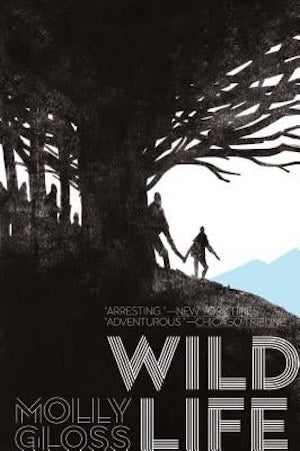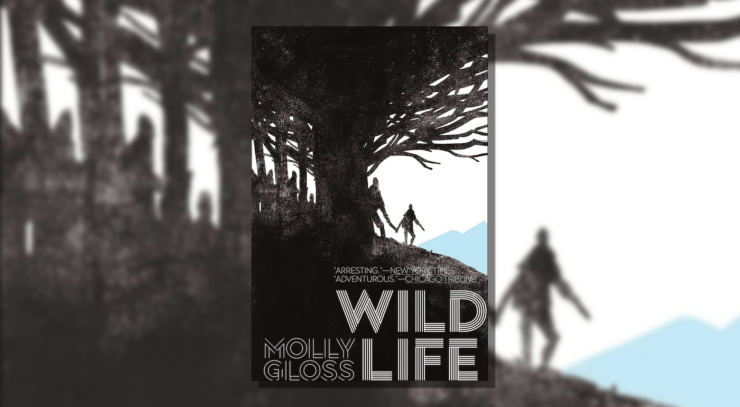Really good fiction can build a world so solidly that it seems more real than consensual reality. Molly Gloss is that good. Wild Life takes us deeper into the world of the Sasquatch than any of the Bigfoot-hunting documentaries—and tells us at least as much about the cryptids.
Because she’s writing a novel, Gloss can go where Bigfooters can’t—though they dearly wish they could. Her story is a slow burn; it takes its time getting started. But that’s part of its spell. It’s shaping a universe and populating it with meticulously drawn characters.
There’s something I call “period sense,” which is the ability of a historical novelist to recreate a time and a place so credibly and so completely that even an expert in the period can concede that they got it right. It’s a rare skill. To step outside of the writer’s own period and world view. To evoke the past as it demonstrably was, in primary sources. To write characters who think and speak and act as they would then, and not as contemporary characters in period dress.
Gloss has period sense. She sets her novel in the early twentieth century, in the rough, raw logging towns of the Pacific Northwest. They’re real towns, with real history; she takes us deep inside them, and out into the wilderness beyond, which is a real wilderness, with places that we can find on a map of our own world.
She tells her story in layers. First, in the prologue, a modern descendant discovers an ancestor’s journal. Then we read the journal itself, interspersed with snippets from the author’s fiction, and quotations from various primary and secondary sources.
Charlotte or Charlie Drummond is a single mother of five boys, who lives on a farm outside the town of Yacolt in Washington. She has a housekeeper with family drama of her own, and neighbors who help her manage it all. She makes a living writing potboilers, bits of which she includes in the journal.
Buy the Book


Wild Life
Charlotte is an unconventional woman. She wears trousers for practicality, and she’s an outspoken feminist. But she’s not simply a mouthpiece for the woman of 1999, when the novel was written. In her world, it’s 1905. Women have been rising up and demanding the vote, and speaking out for gender equality. Women’s roles are changing. Charlotte is an outlier, but she’s not an anachronism.
She lives in liminal spaces, as a woman and as a colonizer. Her land is, ultimately, stolen land, taken from the Native peoples, and it’s been clear-cut by the rampant greed of the timber companies. The great American wilderness is all but gone, the forest primeval hewn down and plowed under by the white man’s progress.
Charlotte writes adventure stories in which intrepid heroines foray boldly into the far corners of the world. Her own life teeters between the obligations of motherhood and the writer’s need for solitude. There’s no husband in the picture—he’s gone and presumed dead—and she’s distinctly lukewarm toward the neighbor who would like to become husband number two.
All of this is prologue and setup. The great theme of the American novel, the bold individualist venturing forth into the primordial wilderness, transforms into a kind of elegy for a world that’s rapidly being destroyed. Charlotte leaves her home and her children for the sake of her housekeeper, whose granddaughter has vanished into the wilderness. The child’s father took her on an excursion to the logging camp where he works, and she apparently wandered off—or was taken. Witnesses declare they saw her in the arms of a huge, hairy giant, being carried away into the deep woods.
Melba, the housekeeper, is determined to participate in the search. Charlotte accompanies her to the camp, then persuades her to return to her daughter, the child’s mother, who is pregnant and sickly. Charlotte herself joins the searchers, though it’s clear by this point that they’re unlikely to find the child alive.
It’s the principle of the thing, in Charlotte’s mind. She’s an experienced and knowledgeable wilderness camper—as much because she’s researched it for her novels as because she’s done it herself.
Charlotte is a writer through and through. She keeps up with her journal through all the vicissitudes of her adventure, from the long and difficult journey to the camp, to the perils associated with being female in a camp full of men, to the awkward, half-inarticulate friendship that rises between Charlotte and the lone female logger in the crew.
All through this long prelude, we hear of the Wild Man of the forest, the great shaggy apelike creature who lives in the deep woods and who may have stolen little Harriet for who knows what purpose. Charlotte pens a brief fantasy about him, starring the heroine of her adventure series. He’s a noble savage, gentle and kind, albeit huge and hairy, and he speaks telepathically; he guides her to the home of his people, a utopian city in a hidden valley.
Reality is much less romantic. It’s a long, fruitless search, and a great deal of rain and mud, and a clear demonstration that the real monsters are human. Charlotte slips into a kind of fugue state, traumatized by an attempted rape that she can’t bring herself to tell anyone about. She wanders away from the rest of the searchers, loses track of where she is, and becomes truly lost.
And then at last, in what at first seems to be hallucination born of hunger and exhaustion, she slips fully into the wild world. She comes across a gigantic hairy mother and her daughter and her twin sons. She travels with them; they adopt her. They teach her how to survive in the wilderness.
These are not the noble telepathic savages of the fiction-within-a-fiction. For one thing, they stink. For another, they don’t appear to have a language. They don’t live in any kind of city; they’re wanderers and foragers. They don’t build houses or use tools.
They seem to her to be animals, with less than human intelligence. She gives them human nicknames and projects her biases on them. She admires their strength and their survival skills, and struggles to keep up, but she clings to her belief in human intellectual superiority.
Slowly, as the days and weeks go by, her perceptions change. She slips away from the human world, from human habits and human language. She can’t truly become one of them, but she can begin to understand what they truly are. They have names of their own; they have a language of trills and whistles and hoots.
There is nothing human about them, but they’re not at all the simple animals that she imagined them to be. They’re an image of man before the Fall, and fallen man is destroying their world. He’s clear-cutting the forests they hide in, building roads across their ranges, capturing and killing their children and stringing them up as either trophies or scientific specimens. The most remote parts of the forest are no longer safe; if they’re not hewn down by loggers, they’re trampled over by large parties of what we now call ecotourists.
Gloss even finds a way to explain why there’s no physical evidence of Sasquatch. They make a sacrament of eating their dead, destroying their hides, crushing their bones to dust. Which is ingenious, though that doesn’t cover what might happen to a lone wanderer who dies by accident or illness.
Then again, there’s a whole lot of territory out there, and Sasquatch were or are presumably rare, even without the destruction of their habitat. That, ultimately, may explain why no modern Bigfooter has found anything. Sasquatch went extinct in the early twentieth century. Like the ivory-billed woodpecker, they had nowhere left to live, and nowhere to hide.










